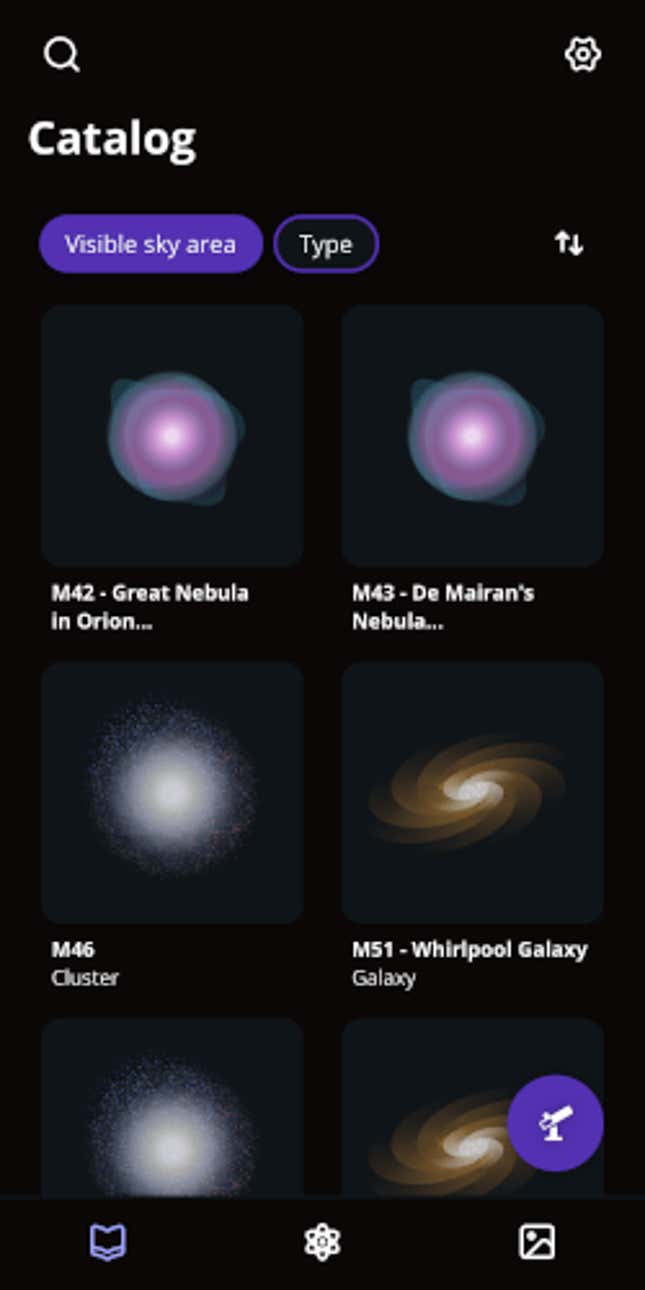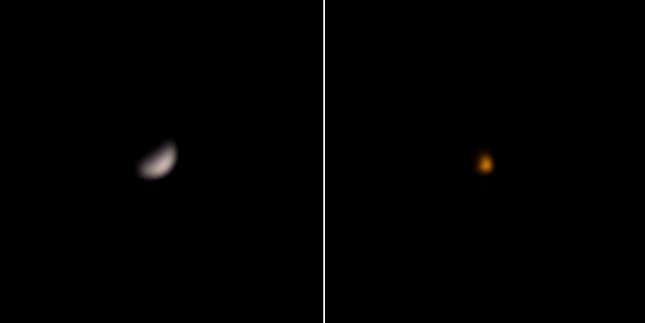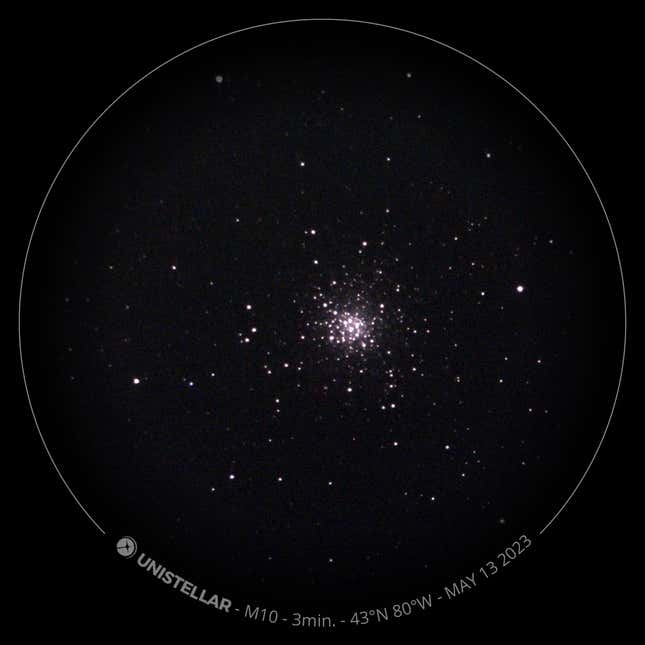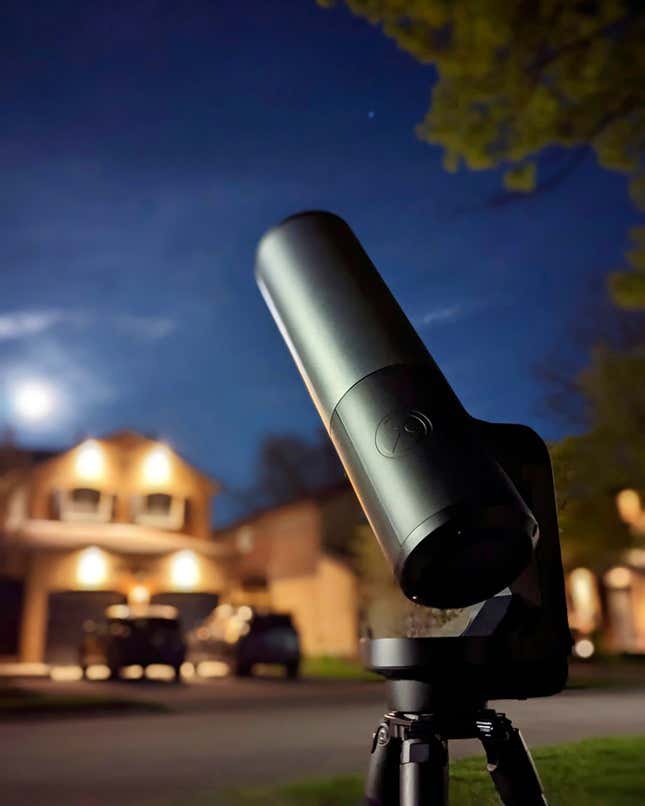Unistellar’s New Smart Telescope Turns Anyone Into a Backyard Astrophotographer
Unistellar’s automated eQuinox 2 is the latest addition to the growing family of smart telescopes, making it possible for backyard astronomers to easily capture clear views of space, even in severely light-polluted conditions. The cost may pose a barrier, as does the absence of an eyepiece, but on balance this telescope has much to offer, whether you’re an experienced astrophotographer or someone who’s just getting started.
As a science reporter and blogger, I’ve been covering astronomy and astronomical phenomena for nearly two decades. It wasn’t until last year, however, that I finally had the opportunity to use an actual telescope, when I reluctantly reviewed the Vaonis Vespera robotic telescope. I say reluctantly because, going into the review, I didn’t know the first thing about telescopes and how to use them.
This turned out to not be a problem, as an entire generation of smart and robotic telescopes are now making it easy for noobs like me to do astronomy without much difficulty. Turns out I was the perfect person to write that review, and doing so gave me the confidence to try out Unistellar’s new smart telescope, the eQuinox 2. Likewise, this turned out to be a very positive experience.
I still consider myself to be an absolute beginner when it comes to telescopes, but the eQuinox 2 allowed me to gather sublime images of deep space within a very short period of time. The learning curve was shallow, allowing me to quickly capture breathtaking views of galaxies, nebulae, star clusters, and planets, and then share those views with friends and family over social media. Special software to minimize the effects of light pollution worked exceptionally well, allowing me to take observations from both my front and back patios. Importantly, my time with the telescope left me wanting to do more, especially as I familiarized myself with the unit and its various offerings.
A portable telescope that uses your phone instead of an eyepiece
As its name suggests, this is the successor unit to the original Equinox telescope, with the upgraded version featuring advancements in optics and image processing; the image resolution is now 25% higher than it was on the original version.
Retailing for $2,499, the eQuinox 2 is marketed by French company Unistellar as a “revolutionary smart telescope” that’s meant for both amateur and experienced astronomers, and for use in “brightly lit urban areas.” The latter most certainly applies to me, as I live in the upsettingly bright Greater Toronto Area. And as mentioned, I’m still a complete beginner when it comes to telescopes, making this a good test of eQuinox’s promised ease-of-use.
Like other smart telescopes on the market, eQuinox 2 does not feature an eyepiece. Instead, users must download the Unistellar app on their Android or iOS devices, such as a smartphone or tablet, to view their celestial images. The absence of an eyepiece poses a potential sticking point for users wanting to view celestial phenomena with their own eyes and not through a screen. This telescope’s big brother, Unistellar’s eVscope 2, does feature an eyepiece, but it’s twice as expensive.
The eQuinox 2 telescope has its own wifi network, making connections a snap and allowing upwards of 10 devices to be connected, making it ideal for group outings. I could move around freely without fear of the connection being dropped, at times as far as 40 feet away from the telescope. One frustration was how observation sessions ground to halt when I moved between apps—something I frequently wanted to do, whether it be to share the previous image while a new one was in the works, or to use a stargazing app to localize other targets (thankfully, it wasn’t necessary to re-orient the telescope when this happened). One feature that I particularly liked was the telescope’s USB port, which is useful for charging handheld devices.

Weighing nearly 20 pounds (9 kilograms) and featuring a 4.5 inch (114 millimeters) mirror, the reflector telescope is reasonably portable, though you’d likely want a backpack or some kind of carrying case to cart it around. Naturally, Unistellar has a backpack available, but it’ll cost you $429. The telescope also comes with a high-quality tripod that’s sturdy and extendable (with the tripod fully extended, the telescope stands more than 6 feet tall). The black and gray eQuinox 2 looks sleek and futuristic, with its lone power button giving it a minimalistic appearance. By don’t let its Spartan look deceive you—this gadget has plenty going on beneath the hood.
Learn how to take photos of stars
After balancing the level (attached to the tripod), attaching the telescope to the tripod, and then pairing the telescope to my iPhone, the time came to orient the device—a critical step to let the telescope know where it’s positioned relative to the starry sky.

As per the quick start guide, I used the virtual joystick in the Unistellar app to steer the telescope towards a batch of stars, which I could view from my phone, and then click the orientation button. The process took me less than a minute to complete, as the telescope uses GPS tracking and star mapping to get the job done.
With the telescope now oriented, I sent it to a bright star for focusing, which is done manually with a focusing wheel at the bottom of the telescope. This tripped me up at first, as the wheel was pretty sensitive and somewhat laggy—I was never satisfied with the results. Had I properly read the instructions, however, I would’ve learned that the unit comes equipped with a Bahtinov mask to assist with the focusing.
The term “Bahtinov mask” intimidated me at first, but it was actually quite easy to use. The device pops off the lens cap and is placed directly onto the telescope opening. While still fixed to that that bright star, I adjusted the focus wheel until the object took on a discernibly star-like shape. That took the guesswork out of focusing and I could now move on. Again, each and every one of these setup steps are parts of the learning curve and are potential points of frustration for the user, but I encountered nothing insurmountable.
A comprehensive and self-contained astrophotography app
With the telescope all set up and oriented, I was finally ready to have some fun.

The Unistellar app provides a handy list of available targets each evening, showing what’s currently available within the user’s field of view, and also what’s about to appear and disappear.
The app offers plenty of sorting options, allowing users to hone their searches to solar system objects (including asteroids and comets), individual stars, galaxies, or whatever specific thing you’re looking for. It’s also possible to search for your own targets and steer the telescope to a set of coordinates, the latter feature being catered to more advanced users.
The app is super helpful and it doesn’t leave you in the dark while you’re in the dark. It provides background information about each target object, such as the nature of the object, its distance from Earth, age, approximate number of stars, its exact coordinates, and the times when it will be visible. The catalog contains over 5,000 celestial objects and some 37 million stars—enough to keep you busy for a while.
Great for astronomy beginners
After choosing a target object, it’s then a simple matter of pressing the “Go to” button on the app. The eQuinox 2 telescope does the rest, spinning and orienting itself to the exact location in the night sky. A view of the object then appears on the user’s handheld device, and with the choice of quick-zooming in or out by factors of 80% or 300%. The app also supports pinch-to-zoom—a feature that I really loved, as it made me feel more connected to my target object, and more like an explorer, especially when zooming in by the maximum 800%. Images gathered by the telescope appear at 6.2-megapixel resolutions and within a reasonably wide field of view (34 x 47 arcminutes for you astronomy nerds).

Most deep field objects, such as galaxies and planetary nebulae, won’t appear instantly on account of how dim they are, but this is where the smart, robotic telescope really shines. After clicking the “Enhanced Vision” button, the telescope begins the process of stacking the incoming images, producing increasingly clearer views of target objects. I was amazed by how quickly a distant object came into view this way, sometimes in less than a minute. The telescope patiently tracks the object in the sky as it creates these long exposures, and it does so smoothly and very quietly. Naturally, the more time spent viewing an object in this mode, the better the image.

Images can be manually saved at any stage in the process—with or without watermarks—and they’re automatically added to your handheld device’s photo gallery for easy access. Saving with watermarks is wise, as it’s easy to forget the names of each object. By default, the telescope autosaves the final view when a session is ended, which proved to be a smart and helpful feature, as I occasionally moved on to the next target without remembering to save.

Depending on the object, the images I got out of the eQuinox 2 were colorful, clear, and at times jaw dropping. I often found myself running inside the house to show off my favorite images to my wife, and then sharing on social media. Deep field objects sometimes appeared faint or fuzzy, but they almost always turned out well. The same cannot be said for closer objects, such as planets and the Moon, which tended to come out blurry and underwhelming (that said, seeing Venus as a crescent object was admittedly a cool experience).
A versatile telescope
I was also able to take manual control of the eQuinox 2 by using the virtual joystick, with the handy slow mode feature allowing me to perform super precise movements. With an 11-hour battery life, I never felt that my outings needed to be rushed (the app tells you how much battery life is left), and with 64 Gigabytes of local storage on the telescope, I just kept taking pictures one after another.

The device’s autonomous Smart Light Pollution Reduction feature worked well, alleviating the effects of nearby streetlights and the general ambient light coming from my city. All images shown in this article were taken from either my front or back yard. On the downside, eQuinox is not waterproof, so users will need to take care to not get the unit wet.

The telescope automatically adjusts for brightness and contrast, but the option exists to manually control these settings. I found that the automatic mode worked very well, but there were occasions when I wanted a darker background, for example, and the manual mode made that possible.
Take photos of the sun
Telescopes make star gazing possible, but today’s launch of Unistellar’s Smart Solar Filter now makes it possible to gaze directly at our host star, the Sun. The new filter, which is universal to all Unistellar telescopes, makes live imaging processing possible by blocking out 1/100,000th of the Sun’s incoming light.

And with the images beamed directly to your smartphone or tablet, you won’t be tempted to look up and expose your eyes to the Sun’s harmful rays (the filter also works with Unistellar telescopes fitted with eyepieces). In addition to scanning for sunspots, users can use the filter to capture unique views of solar eclipses. The Smart Solar Filter retails for $249, with shipping expected in September.
Do actual science and save the planet
One of the cooler aspects of owning an eQuinonx 2 is the opportunity to perform citizen science. The app has a dedicated citizen science section, in which users, working in collaboration with other members, can sign up for actual observational campaigns run by NASA and the SETI Institute. Specific observations include asteroid occultations, exoplanet transits, comet tracking, and even focusing on supernovae as they appear. Users can also track asteroids that potentially pose a risk to Earth. Previous citizen science campaigns include NASA’s DART mission to deflect an asteroid and ongoing investigations of TESS exoplanets.
The eQuinox 2 is a sensible, if expensive, smart telescope
The price tag of eQuinox 2 makes it costlier than many traditional telescopes, which typically retail from several hundred dollars through to around $1,600. Comparable telescopes in the eQuinox 2 price range include the Celestron NexStar 8SE and the aforementioned Vaonis Vespera.
Going the other way, Unistellar has a higher end option—the eVscope 2, which retails for $4,899. The eVscope 2 telescope is meant for more experienced astronomers, featuring a Nikon-developed eyepiece (with enhanced contrast, a deep black image, and an array of lenses) and a higher image resolution of 7.7 megapixels.
Ultimately, I’m a fan of the eQuinox 2. I looked forward to each star-gazing session, knowing that the technology would not hinder the ultimate purpose of wanting a telescope: performing astronomy, collecting cool images, and getting that awesome sense of being a speck in the universe.
Unistellar’s automated eQuinox 2 is the latest addition to the growing family of smart telescopes, making it possible for backyard astronomers to easily capture clear views of space, even in severely light-polluted conditions. The cost may pose a barrier, as does the absence of an eyepiece, but on balance this telescope has much to offer, whether you’re an experienced astrophotographer or someone who’s just getting started.
As a science reporter and blogger, I’ve been covering astronomy and astronomical phenomena for nearly two decades. It wasn’t until last year, however, that I finally had the opportunity to use an actual telescope, when I reluctantly reviewed the Vaonis Vespera robotic telescope. I say reluctantly because, going into the review, I didn’t know the first thing about telescopes and how to use them.
This turned out to not be a problem, as an entire generation of smart and robotic telescopes are now making it easy for noobs like me to do astronomy without much difficulty. Turns out I was the perfect person to write that review, and doing so gave me the confidence to try out Unistellar’s new smart telescope, the eQuinox 2. Likewise, this turned out to be a very positive experience.
I still consider myself to be an absolute beginner when it comes to telescopes, but the eQuinox 2 allowed me to gather sublime images of deep space within a very short period of time. The learning curve was shallow, allowing me to quickly capture breathtaking views of galaxies, nebulae, star clusters, and planets, and then share those views with friends and family over social media. Special software to minimize the effects of light pollution worked exceptionally well, allowing me to take observations from both my front and back patios. Importantly, my time with the telescope left me wanting to do more, especially as I familiarized myself with the unit and its various offerings.
A portable telescope that uses your phone instead of an eyepiece
As its name suggests, this is the successor unit to the original Equinox telescope, with the upgraded version featuring advancements in optics and image processing; the image resolution is now 25% higher than it was on the original version.

Retailing for $2,499, the eQuinox 2 is marketed by French company Unistellar as a “revolutionary smart telescope” that’s meant for both amateur and experienced astronomers, and for use in “brightly lit urban areas.” The latter most certainly applies to me, as I live in the upsettingly bright Greater Toronto Area. And as mentioned, I’m still a complete beginner when it comes to telescopes, making this a good test of eQuinox’s promised ease-of-use.
Like other smart telescopes on the market, eQuinox 2 does not feature an eyepiece. Instead, users must download the Unistellar app on their Android or iOS devices, such as a smartphone or tablet, to view their celestial images. The absence of an eyepiece poses a potential sticking point for users wanting to view celestial phenomena with their own eyes and not through a screen. This telescope’s big brother, Unistellar’s eVscope 2, does feature an eyepiece, but it’s twice as expensive.
The eQuinox 2 telescope has its own wifi network, making connections a snap and allowing upwards of 10 devices to be connected, making it ideal for group outings. I could move around freely without fear of the connection being dropped, at times as far as 40 feet away from the telescope. One frustration was how observation sessions ground to halt when I moved between apps—something I frequently wanted to do, whether it be to share the previous image while a new one was in the works, or to use a stargazing app to localize other targets (thankfully, it wasn’t necessary to re-orient the telescope when this happened). One feature that I particularly liked was the telescope’s USB port, which is useful for charging handheld devices.

Weighing nearly 20 pounds (9 kilograms) and featuring a 4.5 inch (114 millimeters) mirror, the reflector telescope is reasonably portable, though you’d likely want a backpack or some kind of carrying case to cart it around. Naturally, Unistellar has a backpack available, but it’ll cost you $429. The telescope also comes with a high-quality tripod that’s sturdy and extendable (with the tripod fully extended, the telescope stands more than 6 feet tall). The black and gray eQuinox 2 looks sleek and futuristic, with its lone power button giving it a minimalistic appearance. By don’t let its Spartan look deceive you—this gadget has plenty going on beneath the hood.
Learn how to take photos of stars
After balancing the level (attached to the tripod), attaching the telescope to the tripod, and then pairing the telescope to my iPhone, the time came to orient the device—a critical step to let the telescope know where it’s positioned relative to the starry sky.

As per the quick start guide, I used the virtual joystick in the Unistellar app to steer the telescope towards a batch of stars, which I could view from my phone, and then click the orientation button. The process took me less than a minute to complete, as the telescope uses GPS tracking and star mapping to get the job done.
With the telescope now oriented, I sent it to a bright star for focusing, which is done manually with a focusing wheel at the bottom of the telescope. This tripped me up at first, as the wheel was pretty sensitive and somewhat laggy—I was never satisfied with the results. Had I properly read the instructions, however, I would’ve learned that the unit comes equipped with a Bahtinov mask to assist with the focusing.
The term “Bahtinov mask” intimidated me at first, but it was actually quite easy to use. The device pops off the lens cap and is placed directly onto the telescope opening. While still fixed to that that bright star, I adjusted the focus wheel until the object took on a discernibly star-like shape. That took the guesswork out of focusing and I could now move on. Again, each and every one of these setup steps are parts of the learning curve and are potential points of frustration for the user, but I encountered nothing insurmountable.
A comprehensive and self-contained astrophotography app
With the telescope all set up and oriented, I was finally ready to have some fun.

The Unistellar app provides a handy list of available targets each evening, showing what’s currently available within the user’s field of view, and also what’s about to appear and disappear.
The app offers plenty of sorting options, allowing users to hone their searches to solar system objects (including asteroids and comets), individual stars, galaxies, or whatever specific thing you’re looking for. It’s also possible to search for your own targets and steer the telescope to a set of coordinates, the latter feature being catered to more advanced users.
The app is super helpful and it doesn’t leave you in the dark while you’re in the dark. It provides background information about each target object, such as the nature of the object, its distance from Earth, age, approximate number of stars, its exact coordinates, and the times when it will be visible. The catalog contains over 5,000 celestial objects and some 37 million stars—enough to keep you busy for a while.
Great for astronomy beginners
After choosing a target object, it’s then a simple matter of pressing the “Go to” button on the app. The eQuinox 2 telescope does the rest, spinning and orienting itself to the exact location in the night sky. A view of the object then appears on the user’s handheld device, and with the choice of quick-zooming in or out by factors of 80% or 300%. The app also supports pinch-to-zoom—a feature that I really loved, as it made me feel more connected to my target object, and more like an explorer, especially when zooming in by the maximum 800%. Images gathered by the telescope appear at 6.2-megapixel resolutions and within a reasonably wide field of view (34 x 47 arcminutes for you astronomy nerds).

Most deep field objects, such as galaxies and planetary nebulae, won’t appear instantly on account of how dim they are, but this is where the smart, robotic telescope really shines. After clicking the “Enhanced Vision” button, the telescope begins the process of stacking the incoming images, producing increasingly clearer views of target objects. I was amazed by how quickly a distant object came into view this way, sometimes in less than a minute. The telescope patiently tracks the object in the sky as it creates these long exposures, and it does so smoothly and very quietly. Naturally, the more time spent viewing an object in this mode, the better the image.

Images can be manually saved at any stage in the process—with or without watermarks—and they’re automatically added to your handheld device’s photo gallery for easy access. Saving with watermarks is wise, as it’s easy to forget the names of each object. By default, the telescope autosaves the final view when a session is ended, which proved to be a smart and helpful feature, as I occasionally moved on to the next target without remembering to save.

Depending on the object, the images I got out of the eQuinox 2 were colorful, clear, and at times jaw dropping. I often found myself running inside the house to show off my favorite images to my wife, and then sharing on social media. Deep field objects sometimes appeared faint or fuzzy, but they almost always turned out well. The same cannot be said for closer objects, such as planets and the Moon, which tended to come out blurry and underwhelming (that said, seeing Venus as a crescent object was admittedly a cool experience).
A versatile telescope
I was also able to take manual control of the eQuinox 2 by using the virtual joystick, with the handy slow mode feature allowing me to perform super precise movements. With an 11-hour battery life, I never felt that my outings needed to be rushed (the app tells you how much battery life is left), and with 64 Gigabytes of local storage on the telescope, I just kept taking pictures one after another.

The device’s autonomous Smart Light Pollution Reduction feature worked well, alleviating the effects of nearby streetlights and the general ambient light coming from my city. All images shown in this article were taken from either my front or back yard. On the downside, eQuinox is not waterproof, so users will need to take care to not get the unit wet.

The telescope automatically adjusts for brightness and contrast, but the option exists to manually control these settings. I found that the automatic mode worked very well, but there were occasions when I wanted a darker background, for example, and the manual mode made that possible.
Take photos of the sun
Telescopes make star gazing possible, but today’s launch of Unistellar’s Smart Solar Filter now makes it possible to gaze directly at our host star, the Sun. The new filter, which is universal to all Unistellar telescopes, makes live imaging processing possible by blocking out 1/100,000th of the Sun’s incoming light.

And with the images beamed directly to your smartphone or tablet, you won’t be tempted to look up and expose your eyes to the Sun’s harmful rays (the filter also works with Unistellar telescopes fitted with eyepieces). In addition to scanning for sunspots, users can use the filter to capture unique views of solar eclipses. The Smart Solar Filter retails for $249, with shipping expected in September.
Do actual science and save the planet
One of the cooler aspects of owning an eQuinonx 2 is the opportunity to perform citizen science. The app has a dedicated citizen science section, in which users, working in collaboration with other members, can sign up for actual observational campaigns run by NASA and the SETI Institute. Specific observations include asteroid occultations, exoplanet transits, comet tracking, and even focusing on supernovae as they appear. Users can also track asteroids that potentially pose a risk to Earth. Previous citizen science campaigns include NASA’s DART mission to deflect an asteroid and ongoing investigations of TESS exoplanets.
The eQuinox 2 is a sensible, if expensive, smart telescope
The price tag of eQuinox 2 makes it costlier than many traditional telescopes, which typically retail from several hundred dollars through to around $1,600. Comparable telescopes in the eQuinox 2 price range include the Celestron NexStar 8SE and the aforementioned Vaonis Vespera.
Going the other way, Unistellar has a higher end option—the eVscope 2, which retails for $4,899. The eVscope 2 telescope is meant for more experienced astronomers, featuring a Nikon-developed eyepiece (with enhanced contrast, a deep black image, and an array of lenses) and a higher image resolution of 7.7 megapixels.
Ultimately, I’m a fan of the eQuinox 2. I looked forward to each star-gazing session, knowing that the technology would not hinder the ultimate purpose of wanting a telescope: performing astronomy, collecting cool images, and getting that awesome sense of being a speck in the universe.
